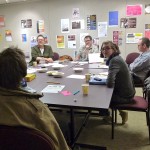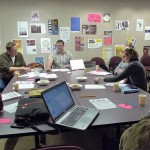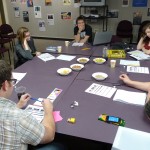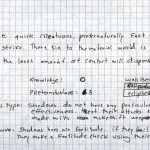RPG Project 01: Beyond the Shadow’s Reach
March 27th, 2012, Haverford, PA
Project team: Ted Purves & Zachary Walter
Participants: Alicia Harder, Melissa Lee-Litowitz, John Muse, Kostyantyn Viktorov, James Weissinger,
The Role-Playing Game (RPG) project that we crafted while we were at Haverford, Beyond the Shadow’s Reach, is part of an open-ended set of projects created by a small group of collaborators spread between the California College of the Arts and The University of South Dakota. This group also includes Jacob Wick and Floris Schönfeld. One of the primary aims of the project is to explore the possibilities of an improvised, group narrative and its potential to allow participants “go through” to other worlds through the mechanisms of play and the suspension of disbelief.
The coordination of these narratives will be facilitated by the use of RPG gaming systems. The gameplay sessions are variously documented with audio recording, games notes and ephemera and short interviews. This documentation is used to generate small scenes, scripts and encounters. Through representation, documentation and re-performance, this creation of another world will be made public in various forms.
While we were framing the project, Jacob Wick and I compiled some notes, several of which are reproduced in the following paragraphs.
…. Dungeons and Dragons‘ persistent emphasis on “world-building” and “character creation” as an intergral part of gameplay provides an interesting platform for thinking about the application of the gaming “energy” to larger, non-gameplaying applications. If “worlds” can be created so readily, where do they exist, and for whom? Similarly, if characters can be created for short or long term lives in an alternate world, what other potential lives (literary, dramatic, psychological) might these characters have?
….How can Dungeons & Dragons become a model through which to re-imagine our engagement with the world? What is it about the embodied collective imagining that happens in a game that is so intriguing to us (I think that was a point of mutual interest)? If actually playing D&D seems important, which it does, then why? To close the ironic distance? To actually understand the experience of collective embodied imagination?
…Additionally, what relations can be made between the practices of Dungeons and Dragons gaming and the practices of contemporary art-making? Dungeons and Dragons (and its related family of games) are somewhat unique in the universe of games in requiring the utilization of “creative” forms (which range from improvisatory role-playing to drawing maps to crafting narrative environments) as the basis for game-play. Can the critical and creative strategies from one practice be moved to the other? If so, how could this re-align ways of thinking about two areas of creative production that have been historically “distant?
For Beyond the Shadow’s Reach at Haverford, we took one day, most of March 27th, to design a simple RPG system. This system was built around a set of five character classes and worked with a unique dice mechanic that relied on opposed rolling of both black and white 6-sided dice. Then we constructed a scenario wherein the players were all citizens of a remote village who woke up on the morning after an eclipse to find that everyone else in their village had disappeared. Upon closer examination, they noticed that their own shadows were also missing. Throughout a series of encounters, they meet an old hermit, visit a goblin village, and fight a battle against living shadows—possibly their own.
They also learn that a child destined to be sacrificed to the eclipse had been abducted from the altar by its mother in an effort to save it from its fate. The adventure concluded at the point where the group of players needed to decide whether to pursue the fleeing mother and return the sacrifice, or to journey to the shadow mountain to confront the gods who demanded the sacrifice of the child.
In reviewing the audio recordings that were made of this game session, we found a short sequence of of game dialogue wherein the players are really “dialed-in” to the narrative of the game. It was at the point in the game where they discovered that not only were their own shadows missing, but that from all appearances there were shadows moving through the village that were “missing” their people. At this point, the players are talking fluidly and with some urgency about what their characters should do next, whether to pursue the shadows, whether they are to be treated as lost family or as menaces. Listening back to that set of moments, it not only sounds like the dialogue of people enjoying a game, but it also tells a micro-story of conflicting emotions and impulses, one that sparkles as it unfolds.
In the early part of the summer, we will craft a script from that short sequence and film a re-enactment. Stay tuned!
—Ted Purves & Zachary Walter, 2012
See all posts about Ted Purves.









Pingback: Lecture Series: Interim Report